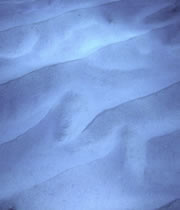Bacterial batteries clean up

The sea bed could be one big battery. <br>© Almay <br>
Researchers name the microbes that could produce power by munching pollution.
Bacteria could clear up oil spills and generate electricity at the same time. US scientists have identified microbes that produce power as they digest organic waste1.
The bacteria strip electrons from carbon in ocean sediments to convert it into the carbon dioxide they need for metabolism and growth. Usually the organisms just dump the electrons onto iron or sulphate minerals on the ocean floor.
But the bugs will just as happily pile electrons onto one electrode of an electrical circuit. As researchers at Oregon State University in Corvallis discovered early last year, you can make a battery by planting an electrode in sea-floor sediments and leaving the other in the sea water above2.
This discovery raised hopes that the seabed might be exploited as a natural low-level power source for the equipment that monitors water current and temperature, which is widely used to guide navigation.
The Oregon team knew that the electrical energy was coming from microorganisms, but they didn’t know which creatures were involved. Now Derek Lovley of the University of Massachusetts at Amherst and colleagues have identified the culprits by making sediment batteries in the laboratory and analysing the bacteria clustered on one of the electrodes. The organisms belong to the family Geobacteraceae.
Lovley’s team also found that some freshwater-dwelling members of the family can do the same thing. These might be put to work in aquifers contaminated by oil or sewage, Lovley suggests.
Freshwater Geobacteraceae can break down petroleum in polluted groundwater on their own, but are often hampered by the lack of sufficient electron acceptors (such as the iron minerals). By providing these bacteria with an electrode that carts the electrons away, researchers could help bioremediation to proceed – and can capture a little electricity into the bargain.
References
- Bond, D. R., Holmes, D. E., Tender, L. M. & Lovley, D. R. Electrode-reducing microorganisms that harvest energy from marine sediments. Science, 295, 483 – 485, (2002).
- Reimers, C. E., Tender, L. M., Fertig, S. & Wang, W. Title. Environmental Science & Technology, 35, 192 – 95, (2001).
Media Contact
All latest news from the category: Ecology, The Environment and Conservation
This complex theme deals primarily with interactions between organisms and the environmental factors that impact them, but to a greater extent between individual inanimate environmental factors.
innovations-report offers informative reports and articles on topics such as climate protection, landscape conservation, ecological systems, wildlife and nature parks and ecosystem efficiency and balance.
Newest articles

High-energy-density aqueous battery based on halogen multi-electron transfer
Traditional non-aqueous lithium-ion batteries have a high energy density, but their safety is compromised due to the flammable organic electrolytes they utilize. Aqueous batteries use water as the solvent for…

First-ever combined heart pump and pig kidney transplant
…gives new hope to patient with terminal illness. Surgeons at NYU Langone Health performed the first-ever combined mechanical heart pump and gene-edited pig kidney transplant surgery in a 54-year-old woman…

Biophysics: Testing how well biomarkers work
LMU researchers have developed a method to determine how reliably target proteins can be labeled using super-resolution fluorescence microscopy. Modern microscopy techniques make it possible to examine the inner workings…





















